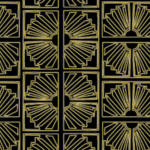Pervasiveness of Art Deco in America

Classic art deco sunburst.
One of the most interesting things about the Art Deco period is how omni-present, or wide-spread, this decorative style was in the United States. It was applied to all the decorative arts – from iron railings to ceramic doo-dads to architecture and faucets. It was found in every small town in America, from local pottery works to furniture makers and textile manufacturers. It was done up in every major city all the way from fancy architects and designers in New York to California and found in every small city in corner gas stations and movie theaters. It was regionalized like the Atchison, Topeka & Sante Fe railroad campaign by Taos artists to spur on visitors to the southwestern American Indians. It was in the movies (Cedric Gibbons) and on theater sets (Norman Bel Geddes), in magazines (Vogue) and clothes (available anywhere through the Sears, Roebuck & Co. catalog). It was for the middle-classes and the well to-do, from bakelite jewelry to emeralds and gold. It was even for the less prosperous as many five-and-dimes were decorated in art deco style, like the S. H. Kress & Co. chain that populated main streets across America. Woolworth’s–one of the biggest five-and-dime stores–sold transfer patterns for do-it-yourself art deco craft projects. You might say America threw its head back and roared art deco.
I think because of the extent and variety of art deco goods in America, this enduring art form is forever tied to the time-period of the 1920’s and 1930’s and its technological innovations. It’s broad scope and clear style continues to inspire us and allows us to carry a little nostalgia for a time when drawing and producing abstract lines and shapes was exotic and new and ANYONE could do it–and there is nothing more American than to embrace a concept that anyone can do.


